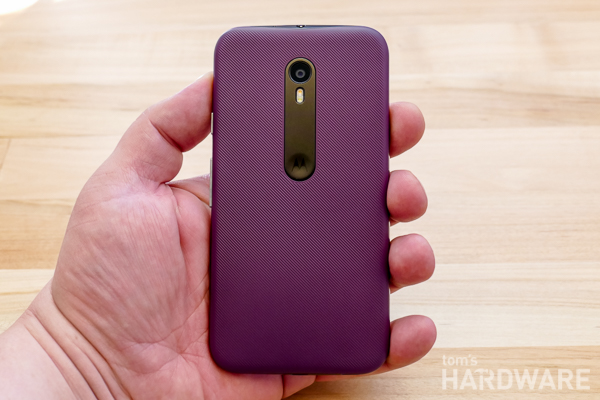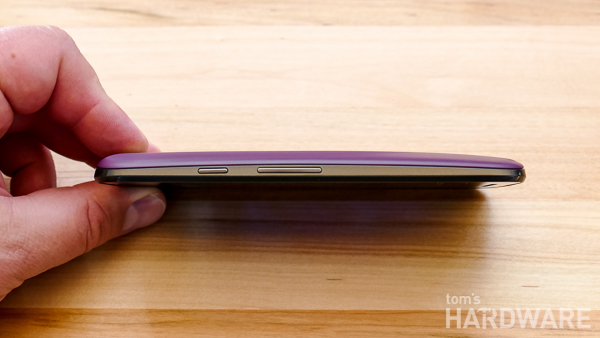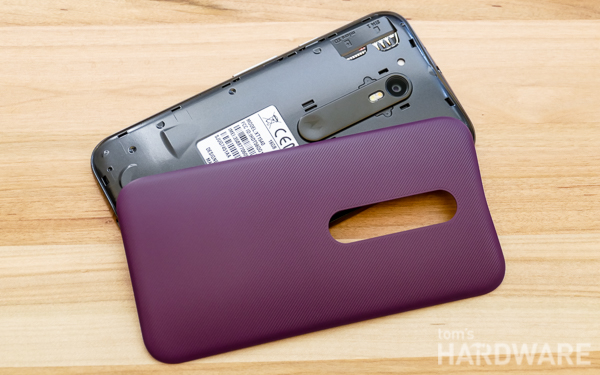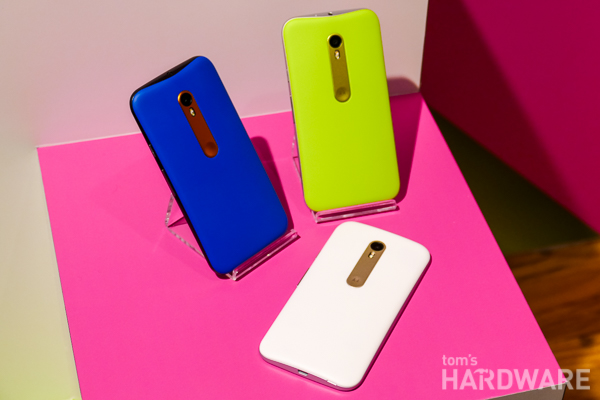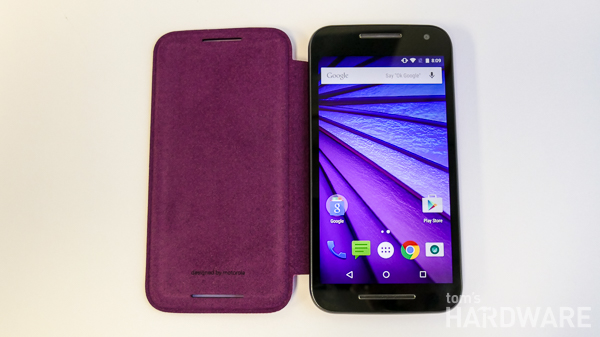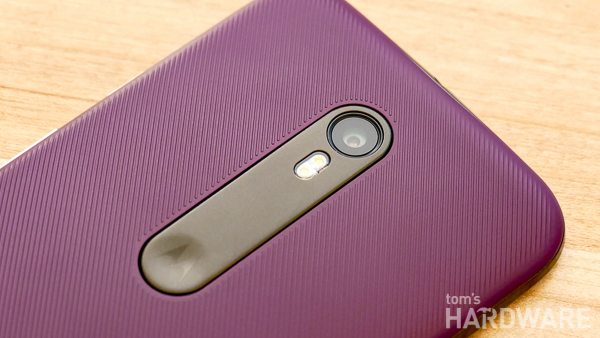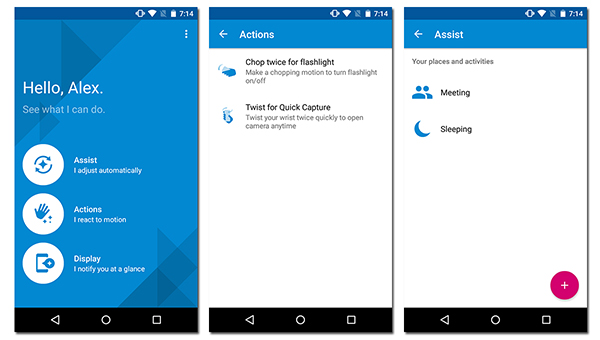Hands On Video Of The New Motorola Moto G (2015) Smartphone
The third phone announced at last Tuesday's Motorola event was the third-generation Moto G. Although it is officially called the Moto G (3rd gen), we'll be referring to it as the Moto G (2015).
The Moto G was launched in late 2013, and it, along with its follow-up the Moto G (2014), quickly became Motorola's top-selling device. The Moto G was Motorola's biggest selling product in India, and at this week's event it announced that it was the best-selling phone in Brazil for 12 straight months.
In fact, the G is probably single-handedly the handset that has kept Motorola in business. Its higher-end phones like the Moto X, while very well received, haven't exactly been flying off the shelves. So the new Moto G has some pretty big shoes to fill.
The challenge for Motorola has been how to improve an already great budget device while still keeping the price low. It also has to make sure that there are clear differentiators between the G and its mid-range devices, like the new Moto X Play and Moto X Style. If the G is too well equipped but still well-priced, it would potentially eat into the sales of the higher-margin flagship phones.
The Moto G (2015) is already on sale through both carriers and unlocked online from Motorola, Amazon and Best Buy. Read on for our initial impressions of the device.
Hardware Specifications
| SoC | Qualcomm Snapdragon 410 (MSM8916) 1.4 GHz 64-bit quad-core processor (4 x Cortex-A53) with Adreno 306 GPU |
|---|---|
| Display | 5-inch HD TFT LCD display (1280 x 720, 294 ppi) with Gorilla Glass 3 |
| Memory | 8/16 GB eMMC ROM, 1/2 GB LPDDR3 RAM / microSD slot for up to 32 GB card |
| Camera | Rear: 13MP with f/2.0 aperture & 1/3.0" Sony Exmor RS IMX214 sensor / 76-degree wide angle / Dual LED CCT flashFront: 5MP with f/2.2 aperture with 72-degree wide angle lens |
| Battery | 2,470 mAh (non-removable) |
| Operating System | Android 5.1.1 Lollipop |
| Size & Weight | 142.1 x 72.4 x 6.1 to 11.6 mm, 155 g (5.59 x 2.85 x 0.24-0.48 inches, 5.47 oz.) |
| Environment Protection | Water-resistant, IPX7 rated |
| Network | XT1540 model: 4G LTE cat. 4 / HSPA+ / GSM (LTE Bands 2, 4, 5, 7, 12, 17)XT1548 model: 4G LTE cat. 4 / HSPA+ / CDMA/ TD-LTE / GSM (LTE Bands 2, 4, 5, 12, 17, 25, 26) |
| Connectivity | Wi-Fi 802.11 b, g, n / Bluetooth 4.0LE / USB 2.0 |
| Audio | Mono speakers |
| Colors | Black, White standard. Customizable on Moto Maker |
| Carriers | US XT1540 model: Unlocked from Motorola, Amazon, and Best BuyUS XT1548 model: Sprint Prepaid, US Cellular, Virgin MobileCDN XT1540 model: Bell, Koodo, Sasktel, Telus and Virgin Mobile |
| Pricing | Starting at $180 US / $200 CDN for 8 GB/1 GB Model |
The Moto G (2015) uses the same quad-core SoC as the Moto E (2nd Gen) 4G we recently reviewed. It is a 64-bit chip, though how much that impacts performance on a low-end device like this is questionable. Its 1.4 GHz clock speed is higher than the Moto E's, which ran at 1.2 GHz. In comparison, the Moto G (2014) had a Snapdragon 400 SoC that also ran at 1.2 GHz and utilized slower Cortex-A7 cores rather than the A-53s of the 410. So you should see a performance boost on the new Moto G, but not by a huge amount. Also, the Adreno 306 GPU of the 410 SoC isn't any more powerful than the 305 of the 2014 G's 400 SoC.
Seeing as this hardware still only has to push pixels on an HD screen, the Snapdragon 410 is still sufficiently powerful for the class of phone that the Moto G (2015) is. It also helps that it is running clean, almost-stock Android that isn't as much of a drain on the a phone's resources as the custom UI's of other OEMs.
Get Tom's Hardware's best news and in-depth reviews, straight to your inbox.
Despite that, it would perhaps have been nice to see the new Moto G with an even bigger jump in performance over its predecessor, and be equipped with the octo-core Snapdragon 415 that has a much better Adreno 405 GPU. However, with that SoC only being announced in February of this year, there probably wasn't enough time to incorporate it into the 2015 G.
The Moto G (2015) still has an HD screen of average quality. In fact, it looks to be the same panel as the 2014 model, so isn't particularly bright. It is covered in Gorilla Glass 3, not some cheaper unbranded scratch-resistant glass that doesn't have the same feel. Cost cutting in this area is something that other budget phones are usually guilty of.
Frustratingly, the model with 8 GB of storage only has a paltry 4 GB of free space. This makes the entry-level Moto G (2015) almost useless without a microSD card. At least there is a microSD slot, though, something that many other phones have dropped in 2015. Still, 16 GB of storage should have been base model, and the next up should be a model with 32 GB.
Another cost cutting measure is 1 GB of RAM on the base G. This low amount won't affect application too much because most apps have been optimized to run just as smoothly on lower-end phones. However, it will impact multitasking performance on the G. We suppose including 2 GB of RAM on the base model would impact the margins too much, not allowing Motorola to get to the sub-$200 price point and still keep the (probably expensive) 13MP camera sensor.
The Moto G (2015)'s non-removable 2,470 mAh battery combined with the 410 SoC and HD screen should mean awesome battery life. This increase in size is a nice step up from the 2,070 mAh of the 2014 model. Motorola claimed that it should last up to 24 hours with mixed use. There is no mention of Turbo Charge (Motorola's name for Qualcomm's Quick Charge 2.0) support, but the Snapdragon 410 does support it. However, the Moto G is not listed among the devices that support it on Qualcomm's site. So while the SoC does support it, either Motorola just isn't advertising this feature or hasn't included some required circuitry to enable it.
There is no support for NFC, and one other major strange regression from the 2014 model is that the new Moto G does not have stereo speakers (even though the front design gives the illusion that it does). We don't understand the rationale of removing this feature, which had made the previous Moto G stand out from its other budget competitors.
As for connectivity, there is no 3G-only model anymore, which is good. Every Moto G (2015) model will support LTE. Unlike the Moto X Pure Edition, the new G is not universally LTE banded, so you can't use the unlocked variant on every carrier. The unlocked XT1540 model supports six LTE bands (2, 4, 5, 7, 12, 17) and will work on AT&T, T-Mobile in the U.S., and all Canadian carriers. It won't work on Verizon or Sprint.
There is also an XT1548 CDMA model sold as a prepaid phone by Sprint, US Cellular, and Virgin Mobile. It supports seven LTE bands (2, 4, 5, 12, 17, 25, 26), but crucially, not Verizon's band 13. The Snapdragon 410's Gobi 7-mode modem supports CAT4 LTE, with up to 150 Mbps download speeds.
Hands-On Video
Design
The Moto G (2015) doesn't look too different from the 2014 model, and it has the same design DNA as the Moto X with its curved back. The new Moto G also has the new metal "bar" that runs down the middle of the phone with the logo "dimple" at its end. We were told that it is metal, even though the Moto G is a budget device, which is a nice touch. The power button (which is textured) and volume controls are on the right of the phone and are well placed.
Up top is the headphone jack, and on the bottom there is the USB 2.0 charging port.


The plastic back panel of the Moto G (which is removable for customization) has a nice textured soft-touch finish that resists fingerprints, as do the satin-finished sides. Too many budget phones have high-gloss finishes that look good in the showroom but get ruined the minute you pick the phone up. Also, despite its all-plastic build, the Moto G (2015) is a very solidly-built device that also has a nice amount of weight that adds to its premium feel.
A big addition for the 2015 model is water resistance. Previous Moto Gs had a splash-resistant nano-coating that would allow the phone to survive a spilled drink or rain, but couldn't handle being submerged in water. The IPX7 rating of the new model means that is can be submerged in up to 1 meter of water for 30 minutes. This feature is a great value-add for a budget phone. Most other water-resistant phones are much more expensive flagships, such as the Sony Xperia Z3 Compact.
Customization
The Moto G (2015) is the first G to support Moto Maker – Motorola's customization site where you can order a phone customized in your choice of color. Moto Maker is already available in the U.S., UK, France, Germany and Mexico. With the launch of the Moto G (2015), it is also coming to Brazil, which makes sense because the 2014 Moto G was one of the top selling phones in that market.
Through Moto Maker, you can order the new Moto G with either a white or black front bezel, and choose from the different colors for the removable back. The choices are lime, golden yellow, black, white, raspberry, cherry, navy, turquoise and blue cabernet (the color of the unit in our photographs). You can also customize the metal bar below the camera. Like the back, there are ten colors to choose from: lemon lime, dark chrome, light chrome, red, champagne, purple, orange, blue, black and pink.
Unlike the Moto X, there are no other metal parts of the phone that can be customized, and the Moto G's back panel is user removable. If you don't care about changing the color of the metal bar, you will be able to buy the different colored backs yourself and apply them to the phone. This is especially useful if you buy the G in a market without Moto Maker, or from a retailer or carrier that only carries the black or white models.
Another option that can be added on Moto Maker, or purchased separately, is a colored Flip Shell. This accessory comes in black, crimson, raspberry (shown above), blue and turquoise.
Camera
The other big new feature of the Moto G (2015) is its much-improved camera. At the event, Motorola admitted that the cameras on its phones haven't always been the greatest. For 2015, its goal is to give each of their devices a best-in-class camera.
With that goal in mind, the new Moto G comes equipped with the same 13MP camera as the Nexus 6, which is also made by Motorola. This sensor is the 1/3.0" Sony Exmor RS IMX214, a mid-range image sensor also found in the OnePlus One and a number of other phones. While it wouldn't be considered top-end today, it is certainly better than the sensors found in every other budget device.
This sensor has been combined with an f/2.0 lens, which is a pretty decent aperture for a lower-end phone, and the lens has an IR filter coating to help prevent lens flare and chromatic aberrations. Motorola also included the same dual-LED CCT (color correlated temperature) flash as found on the new Moto X Pure and Play. This helps produce more color accurate images when shooting with the flash.
Despite the better camera sensor, the Moto G is still a low-end phone, so you won't find any additional camera features like phase detect autofocus (PDAF) or optical image stabilization (OIS) on it. Around front, the new Moto G has a 5MP camera, which, again, is good for a phone in this price range.
While we haven't had enough time to test out the Moto G (2015)'s camera, it should produce similar results to the Nexus 6, so you can read our review of that phone's camera here. Although there are phones with better cameras available, there aren't any that cost $180!
Software
The Moto G (2015) runs an almost stock version of Android 5.1.1 Lollipop, like the Moto X Style and Play. Motorola has included its own camera and gallery apps and added a suite of its value-add features, but other than that this is stock Android in every other way. In many ways, this makes the Moto G a budget Nexus phone for those looking for the pure Google experience, unencumbered by carrier bloat.
Also, while OS updates still won't come from Google, Motorola has historically delivered them much faster than most OEMs, and there are no carriers standing in your way. Well, that is if you buy the unlocked model. Both the 2013 and 2014 Moto Gs have been updated to Android 5.1, so you can be confident that the new Moto G will receive Android M and probably other future versions of Android. Many budget phones only ever get one OS update at most, and it often takes an excruciatingly long time to be released due to carrier involvement.
In addition, because the unlocked model won't have any carrier involvement, there won't be any useless bloatware or carrier apps. Unfortunately, the models sold by carriers (prepaid in the U.S.) are likely to come with some carrier bloat, though with the limited storage space available on the phone, we hope common sense will prevail and they won't be packed with useless apps. The Canadian demo unit we are testing is mercifully free of bloat too, though we are not sure if what we received has the same software build as the final unit you'll buy from the carrier.
Motorola's value-add to Android are its Moto apps, found on the Moto G (2015) in the Moto 3.0 application. Here is where you configure Moto Assist, Moto Actions and Moto Display. Assist is a simple location-based task app that can automate things like muting the phone when your calendar says you are in a meeting. Actions are gestures controls, like a double twist of your wrist while holding the phone to open the camera apps. Moto Display shows minimal notification icons on the screen when the phone is sleeping.
Still missing on the Moto G (2015) is Moto Voice. Moto voice takes voice control a step further by being able to continuously listen for your voice command without having to interact physically with the phone. This feature is probably not included on the Moto G because of the additional hardware cycles needed to do this on a low-end device, which may impact performance. You can still use the standard "OK, Google" voice control, though.
Availability And Pricing
The new Moto G with 8 GB/1 GB is available from Best Buy and Amazon in either black or white. If you order it directly from Motorola.com, you can upgrade to the 16 GB/2 GB model for an extra $40, and you can, of course, customize it as well. The prepaid model coming from Sprint, US Cellular, and Virgin does not seem to be available at press time.
In Canada, Motorola only sells the 8 GB/1 GB model, and only in black. It is available from Bell, Koodo, Sasktel, Telus and Virgin Mobile. There is no unlocked Moto G (2015) in Canada. The Canadian version is $200 outright at all the carriers, apart from Telus which has it for $230. Because this is a subsidized device in the GWN (Great White North), it is also $0 on a 2-year term.
The Wrap Up
In conclusion, there is a lot to recommend with the Moto G, and it remains one of the best budget phones you can buy. However, Motorola's quest to improve the camera has come at a bit of a cost. We guess the price of the Sony IMX214 sensor drove up the bill of materials for the new Moto G a fair amount, enough so that the stereo speakers were dropped, and 8 GB of storage and 1 GB of RAM is still the base option.
We would have rather seen work on the optics, image processing and capture software with a cheaper 8MP sensor to keep the costs low enough to bump up some other specs of the phone and keep the stereo speakers. The base model's 8 GB of storage isn't enough for anyone, especially as there is only 4 GB of useable storage left once you account for the space taken up by the pre-installed applications.
This practically forces you into buying a microSD card, and although they aren't that expensive, it would have been better if Motorola had simply made 16 GB the base storage option, with 32 GB on the upgraded model. This issue is especially frustrating in Canada, where the 8 GB model is the only option.
In the grand scheme of things, though, the North American market for the Moto G isn't particularly important to Motorola. The bulk of the sales of the previous models were made in emerging markets, and we're pretty sure that the Moto G (2015) is going to be another successful device for Motorola.
Those markets are getting tougher, though, with other OEMs upping their budget phone game, and of course, there is the influx of solid but low-priced Chinese phones (Xiaomi, Meizu, etc.). With the new Moto G not substantially differing from its predecessor, will the addition of water-resistance and a better camera be enough to hold its Asian competition at bay? It's also a little ironic, then, that Motorola's new owners are Lenovo.
The Motorola Moto G (3rd gen) is available now.
Alex Davies is an Associate Contributing Writer for Tom's Hardware, covering Smartphones, Tablets, and Virtual Reality. You can follow him on Twitter. Follow Tom's Hardware on Twitter, Facebook, and Google+.
-
zodiacfml Too bad they downgraded the speakers. It sounds great compared to my Nexus 5. Aside from entertainment, those speakers are useful for handsfree calling. Maybe, that is the exact reason why it can be found only on the Moto X.Reply
Firmware/OS upgrades are commendable though. My friend's first Moto G got upgraded to Lollipop, very good value! -
jaber2 Is that smartphone tiny or does this guy have huge manly hands, that just stopped me in my tracks, is this guy an ex-football lineman or whatReply

